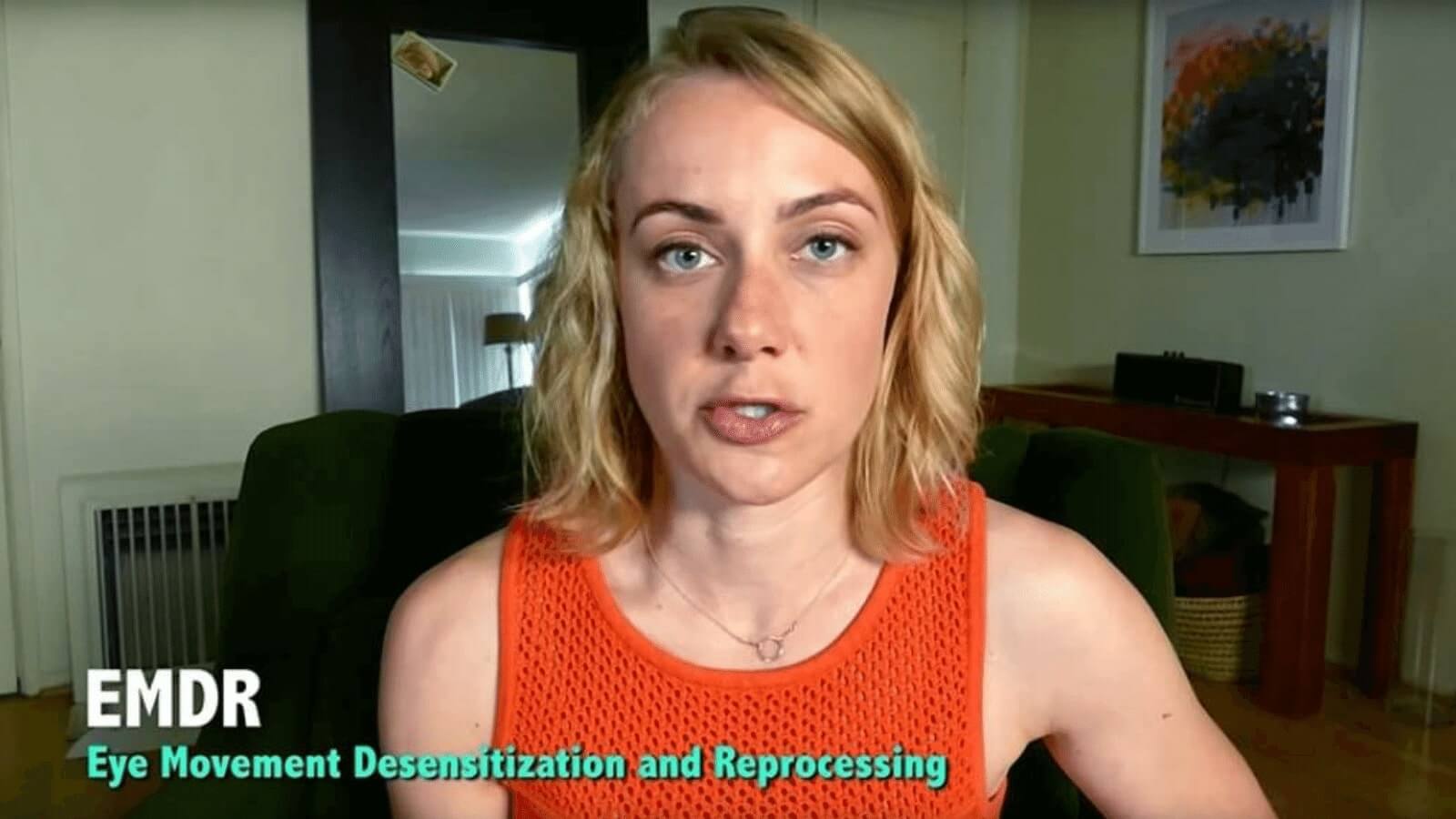What is Eye Movement Desensitization and Reprocessing (EMDR)?
Eye movement desensitization and reprocessing, or EMDR, was first discovered by psychologist Francine Shapiro on a walk through the park.
While reflecting on some of her distressing personal memories, Shapiro noticed that as she moved her eyes, the negative emotions she was experiencing seemed to decrease.
This led to further experimentation with this technique, and eventually EMDR was born. Today, EMDR is widely used in conjunction with other psychological therapies to de-intensify traumatic memories.
How Does EMDR Work?
While a person is receiving EMDR, they conjure up a memory of a past negative emotional experience while focusing on an external stimulus. Often, light beams are used, but other stimuli like tapping, audio stimulation or simply moving a finger laterally in front of the eyes are also common methods.
EMDR takes place in phases, and therapists determine the target memories and future thought to transform the emotion behind the event. When we experience traumatic event or intense and negative emotional experience, our brain develops strong neural pathways associated with that memory.
EMDR works by creating new neural pathways associated with those memories, lessening their intensity over time. Our brains have a natural healing process – just like our bodies heal our wounds – but if the wound is too deep, outside help may be necessary to activate the healing process.
Is EMDR Effective?
Research shows the remarkable effectiveness of EMDR in treating trauma. Studies show that 84 to 90 percent of single-trauma victims no longer meet the criteria for PTSD after only three, 90-minute EMDR sessions.
One of the main draws of this technique is the lack of verbalization necessary.
An EMDR therapist can be effective without knowing many of the details behind the trauma experienced – trauma victims don’t have to articulate their memories out loud and can simply follow their therapist’s instructions in silence.
Some EMDR studies have shown that it can even be helpful when memories of trauma are fragmented or absent altogether, such as in repression or situations like roofie attacks.
Disorders Commonly Treated With EMDR
While EMDR is most recognized as a therapy for trauma disorders, there has also been research supporting its effectiveness in treating:
- Panic disorders
- Dissociative disorders
- Phobias
- Anxiety
- Addiction
- Personality disorders
EMDR for Teens and Young Adults
Especially for teens and young adults, EMDR can be a valuable alternative (or complement) to conventional talk therapy.
It’s particularly effective at this stage of development due to young people’s neuroplasticity – that is, the ability of their brains to create new connections.
EMDR can allow teens and young adults to take their first steps towards recovery long before they would have otherwise, and they have a better chance of success than their older counterparts.
EMDR for Substance Use Disorder and Addiction
It is estimated that as many as 45% of people who are diagnosed with post-traumatic stress disorder also struggle with substance abuse.
In this case, treating trauma is a crucial part of treating or preventing addiction. Many teens and young adults who abuse substances are seeking an escape from the anxiety and pressure they’re experiencing.
EMDR can be a healthy alternative to harmful substances, and provide a way for young people to truly change the way they feel. Though the benefits of EMDR are well documented, therapists who administer EMDR are required to have special training, certifications, and equipment.
If you’re interested in exploring the benefits of EMDR for your teen or young adult, the caring and professional staff at Sandstone are here to help you explore your options – give us a call today at 888-850-1890 to learn more.
Top Questions About EMDR with Patty Dirilten
This video explains:
- Can EMDR be used for teens or young adults?
- Can EMDR be done virtually?
- Is EMDR Hypnosis?
- Can EMDR be done in residential treatment?
- Can anyone do EMDR therapy?
- Can EMDR make you worse?
Real Common Treatable EMDR Podcast Transcript
Clint Mally 0:10
When you get a cut, your body naturally starts healing. You don’t even have to think about it, it just kind of happens.
Lindsey Vass 0:18
But if something gets inside that cut, if there’s something preventing the cut from healing, it can get infected,
Clint Mally 0:25
this little cut suddenly becomes a big deal.
Lindsey Vass 0:30
Trauma is that something it becomes the thing that can prevent someone from healing from a major or even minor life events.
Clint Mally 0:38
Your body does have natural ways to not dwell on events or conflicts from one day to another. But trauma prevents the wound from closing. It makes it vulnerable, open, sensitive.
Lindsey Vass 0:52
In today’s podcast, we take a deep dive into Eye Movement Desensitization and Reprocessing or EMDR therapy to help unlock the body’s natural ability to sort through trauma and find healing. I’m Clint Mally. And I’m Lindsay Vasse.
Clint Mally 1:09
And this is real common treatable, a real talk podcast about overcoming mental health, addiction and substance abuse challenges.
Lindsey Vass 1:25
Talk to Patti dirleton for 10 seconds, and you’ll see that she is super passionate about trauma, especially EMDR.
Patty Dirilten 1:33
So I am Patti dirleton. And I am an outpatient therapist, psychotherapist, and I am also an owner of the Center for insight and connection. And mostly what I do is I treat trauma. I believe that not just me. But EMDR therapists are taught to believe that just about any presentation of a mental health issue is rooted in trauma or negative experiences earlier negative experiences. So there are past experiences that teach people negative beliefs about themselves. And it’s those negative beliefs that then drive the presentation of anxiety, depression, PTSD, eating disorders, addictions, pretty much the majority of things in the DSM.
Clint Mally 2:20
By the way, the DSM stands for a diagnostic and statistical manual of mental disorders.
Lindsey Vass 2:26
So working out trauma is important. But one thing Patti didn’t think about early on in her practice was how regular talk therapy could possibly do more harm than good.
Patty Dirilten 2:36
When you’re doing regular talk therapy, and you’re talking about experiences, I think it runs the risk of re traumatizing because what we have found is that trauma exists in three different parts of the brain. And when we’re just doing regular talk therapy, we’re just getting to one part of the brain. When I was working in substance abuse world primarily, I saw a lot of people with major huge big T traumas. And then on top of it little T traumas. And at the time, I didn’t really I was not specialized in trauma yet, and I was doing the best I can with my CDC and really doing a lot of very good addiction work. But what an hour that I reflect back, what I was actually doing was was connecting with people, and helping them just maybe even talk about their trauma for the very first time. But that’s all we were doing was talking about it so we would have these sessions with all of these things would be brought up. And it was like we were bringing them all up. And then we were like having a stuff on back end. And there was no resolution to that trauma. There was no healing of it. And so there was a little bit of reprieve I think like from the fact that they could maybe tell their story for the first time. It definitely wasn’t for nothing. But now that I understand trauma the way that I do, I believe I think maybe even in a few cases, I was really traumatizing my client.
Clint Mally 4:01
As Patty worked with trauma more and more. She wanted to be able to make sure she was helping people move past their trauma and not just relive it in their sessions. That’s when she started to go deep into EMDR therapy.
Patty Dirilten 4:16
EMDR Eye Movement Desensitization reprocessing, it’s an experiential therapy that targets maladaptive Lee stored material in the brain. So Francine Shapiro was the originator, she discovered EMDR therapy by herself was in the 80s. And she had struggled with something in her relationship or something in her life. And she went for a walk
and as she was walking, she was looking left to right on the sidewalk in front of her during not even methodically it was just something she was noticing about herself. And so She began to explore that and look and was saying, Okay, wow, I feel better when I’m Is it the walk? Is it the me looking back and forth? And she started to question this. So then she started to study it because she was a therapist herself. And she began to put together experiments. And so now we have many random controlled studies that really uphold our understanding of how it works.
Lindsey Vass 5:24
Part of the research theorizes that EMDR mimics what our body does in REM, or rapid eye movement sleep. during REM sleep, most scientists agree that your body is doing a whole bunch of processing.
Clint Mally 5:37
Yeah, basically, it’s like going through all the stuff you did that day and saying, Okay, I need to remember this, or I can forget that. It’s kind of like a computer, clearing the cache so that it can continue to have processing power, and space.
Patty Dirilten 5:52
With REM sleep. It’s a very active sleep cycle asleep stage. So what you’re doing, and that is part of the body’s way of taking information and moving it through to go, what do we do with us, right? Where do we store this? If this thing happened, we stored in this part of the brain, we get rid of it? What are we doing? What are we doing, we dream about the things that happen to us? Everybody’s dreaming, whether we remember those dreams or not?
Lindsey Vass 6:19
To be clear, we still don’t fully know why EMDR works, we just know that it does, we still don’t have the technology to fully measure what’s happening in the brain. So when you hear Patti talking about EMDR, as a hypotheses, that’s why
Patty Dirilten 6:34
and I think the model that is explaining why EMDR works, that is one way, one hypothesis is that we’re literally taking that REM sleep and replicating it and taking material through it, and replicating what goes on in REM sleep. And that is the part we don’t understand fully. That’s the part where we can’t take a pill, we don’t have the technology yet to be able to look at the brain and go okay, what exactly is happening when we take this material and we put this bilateral stimulation, we get the brain to connect to each other and understand what’s going on because you get this shift that happens at the end of it.
Clint Mally 7:15
Let’s break down that term bilateral stimulation, obviously, we can do therapy in our sleep. So one part of EMDR is recreating that cadence of your eyes shifting back and forth during REM sleep while you’re still awake. So
Patty Dirilten 7:31
the bilateral stimulation is really just a part of a much larger comprehensive approach. I use buzzers I usually use tactile bilateral stimulation, where these two things are held in the hand. And then they get turned on. And there’s a buzzing like
Lindsey Vass 7:50
the buzzers held in each hand, because the left hand and then the right hand creating bilateral or across the body stimulation.
Patty Dirilten 7:58
There’s multiple different kinds of bilateral stimulation traditionally went up Francine Shapiro first started this, it was bilateral stimulation where you would have somebody follow your fingers across the midline. That’s the replication of the run sleep. But that stage of sleep where your eyes are, it’s an active stage of sleep where your eyes are crossing a midline. So that’s what the bilateral stimulation is. So originally, it was the eye movement, and then they moved even to a light bar.
Clint Mally 8:30
Here, people would follow a light from left to right. And Lindsay, I don’t know if this crossed your mind. But EMDR kind of reminds me of that old timey hypnosis thing with the pocket watch. Like, look into my eyes.
Lindsey Vass 8:45
Yeah, I could see that like a Jafar from Aladdin situation.
Clint Mally 8:50
Exactly. So I had to ask, is EMDR a form of hypnotism?
Patty Dirilten 8:55
It’s not although I recently attended a CEU, about hypnosis. And we actually had such a good conversation because there was some, like overlap with some of the concepts. But the formal answer is no. EMDR is not hypnosis. What’s really needed for this to be effective is the client’s ability to dual focus, to be able to have one foot in reality in my office and the other one in the memory and the material. So that person has to be very conscious. So even like when you’re working with dissociation, this is a very good treatment with clients who present with dissociation issues, because you’re helping them orient themselves to safety and in their body and being able to be completely present while also in the same space accessing pain. So your eye Absolutely you need absolute consciousness in order to be able to engage in EMDR. So no hypnosis is not the same as EMDR
Lindsey Vass 10:00
Okay, so EMDR is definitely different from hypnosis because you play an active part in the process, you can’t be in a subconscious state to process your trauma.
Clint Mally 10:09
Right. And there’s actually eight stages to EMDR. And you’ll see that this whole bilateral stimulation is only a part of it. And to help us understand it, we ask Patti to walk us through the eight stages, using a big T trauma example.
Lindsey Vass 10:25
Imagine you’re walking through the woods with your family and a hiking trip. It’s a beautiful day, the weather is nice, and you’ve been out for a couple of hours enjoying the fresh air.
Clint Mally 10:35
It’s getting late. So you in the fam are headed back to the car. Just as the sun is beginning to set, the crickets are starting to turn.
Lindsey Vass 10:43
Suddenly, a giant scary bear steps into your path and you are terrified.
Patty Dirilten 10:55
Bear jumps out in front of me. My system goes into fight or flight, I’m spare spraying. I’m yelling and screaming trying to protect my kids. And the bear runs away. I’m okay, everybody’s safe, we go about our vacation, it’s fine. So several months later, I go for a hike and near my home in Illinois. And there’s a wrestling in the woods. And the wrestling triggers my body to to act as if a bear is coming out of the brush. So what’s happening there is that the past is informing the present. And that material is maladaptive Lee stored in my brain, the bear incident is now adaptively stored in my brain, because it can’t hook up with the very adaptive material that I live in Illinois, and there are no bears in Illinois.
Clint Mally 11:44
So now we have a coping mechanism, not a great one either. It stresses us out. And it’s not even connected with context, even even when there’s no bears around. It’s impossible for us to enjoy nature without fearing danger around every bed.
Lindsey Vass 12:00
This brings us to stage one of EMDR taking your history.
Patty Dirilten 12:06
If I was to go to an EMDR therapist that EMDR therapist would take my history would under would understand what why I’m getting triggered while I go on hikes I would come in and maybe that would be my presenting issue. Oh my gosh, I can’t go on hikes, I can’t even walk on sidewalks. I’m so anxious. And maybe even that’s beginning to I’m starting to stay in my house more avoiding going out into the community. And so my EMDR therapist might say, Okay, interesting. And she’d be taking a history. And what she would find in that history is that I had that incident with the bear. So she and I would discover that the bear incident is what’s causing my anxiety and my avoidance symptoms in the present. So then she would target that bear memory, because that’s what would be informing those symptoms in the present. And when we say target, this is how these are the next phases, right? So she would prepare me. So phase one is is history taking. And then she would prepare me and make sure that I was able to state change.
Clint Mally 13:13
What’s important to remember here is that this therapy needs to be done without re traumatizing someone.
Lindsey Vass 13:19
Yes. And this brings us to stage two, which is the preparation stage. Here that therapist is making sure that once this step is brought up, you have the tools you need to not let it trigger you in a negative way. Patti describes two state change exercises that are often done to help clients prepare for the work,
Patty Dirilten 13:38
there’s two that were taught in our basic training. And this is where I think this part is so very important. So the first one is the container exercise. And what we’re doing is we’re teaching people to be able to diffuse it’s diffusion. It’s a visualization of diffusion. So we’re helping people to say, Okay, I have this container that you leave in my office that has a lid on it. So we can put unfinished business material thoughts emotions, into that container so that when you leave my office, you’re not leaving here in any kind of disturbed state. That would be one example. The other example is calm place or safe place, which basically is another visualization that we do with bilateral stimulation, which is the the eye movement part. And that is basically a visualization where we help someone step into a state of relaxation, and they visualize a calmer, safe place. And we have them feel deeper into their bodies and their nervous systems a state of relaxation so that we have that to go to. It’s already established when we’re accessing disturbing material.
Clint Mally 14:55
So remember in Fight Club when the main character creates a calm, peaceful called the cave to deal with the cancer that he doesn’t have. This is kind of like that minus the penguin animal guide.
Lindsey Vass 15:09
Once there has been some prep work, phase three is assessment, and it covers very specific questions that a therapist asks about the trauma someone is about to work through.
Patty Dirilten 15:19
So if it’s the bare memory, the therapist says, Okay, what’s the worst part? What’s the image of the worst part? What’s the negative belief about yourself? This is such an amazing tool. And this is where I gave you the offshoot of beliefs and thoughts. So what’s the negative beliefs? So in this particular case, the negative belief says, I’m not safe, right? I’m not safe. And so the positive belief is, I am safe. The validity of cognition is then measured how true to those words sound? I am safe when you experienced this memory now. Oh, it doesn’t feel true at all. What are you talking about? I don’t feel safe at all. The bear almost got me What are you talking about? Lady? So the validity of cognition is measured. And so what as a clinician, you’re wanting that if you’re trying to get that person to understand that negative belief in the positive beliefs there. That’s what’s there. And that comes in later. So that’s the positive belief we’ve got, we assess the validity of cognition. And then we identify what the feelings are. What are the feelings that you experience as you experienced this memory? Now? Panic fear hall like disbelief. Like I’m so scared, right? So that’s the emotion. Those are the emotions. And then I’m assessing the subjective unit of disturbance, the side? And that is that scale of zero to 10? How disturbing is this material to now? So as I’m experiencing the bare memory, it’s probably an eight or nine. So it’s that high at a turn zero to 1010s? The worst zeros, none at all. And then where do I feel that disturbance in my body? I feel it in my stomach, I mean, my hands and feet. So those are the assessment questions, we’re activating, getting that material activated.
Clint Mally 17:15
This reminds me of a controlled explosion or a controlled burn, II know that you’re going to be working with some potentially dangerous stuff. So it’s important to understand that stuff, or in this case, trauma, and to prepare the environment so that it doesn’t get out of hand.
Lindsey Vass 17:33
Right. I see what you’re saying. So the fire doesn’t spread uncontrollably, or to the explosion doesn’t hurt yourself or anyone when it goes out.
Clint Mally 17:41
Exactly. And when we come back, we’re going to navigate that exact moment. How does an EMDR trained therapist activated trauma, help them process it and work through it to provide healing.
Lindsey Vass 17:55
This podcast is brought to you by sandstone care. Sandstone care helps teens, young adults and their families overcome substance abuse, addiction and mental health challenges. They provide age specific full continuum of care from residential to intensive outpatient services, including EMDR therapy, changes possible and sandstone care is here to help.
Clint Mally 18:19
Now that the therapist has activated the trauma, it’s time to bring the client through it. So what does that even look like?
Lindsey Vass 18:27
This is phase four, or D sensitization or bilateral stimulation. Remember the eyes going back and forth, or hand buzzers when left to right. That’s where these really come in.
Patty Dirilten 18:37
If we go back to me with the bear memory, we’ve activated the bear memory, I’m sitting with the disturbance. I have the image, I have my feelings. I have my cognitive beliefs and I’m feeling it in my body. So I’m activated, and then the bilateral stimulation comes in. And what it does, is it just the idea is it we do says it desensitizes the fear. So E M, Dr. Right? Eye Movement, desensitization reprocessing throughout this whole process, that whole phase, that therapist is going to do a set of bilateral stimulation. And then the person me being the client, my therapist might say, okay, Patti, what do you notice now? And I at first, maybe I start out really high as an eight. And as I do after my first set, I might go oh, it’s not, I feel a little more relaxed. Okay. So then my therapist might say, okay, Patti, what’s the worst part now and it just opens the whole picture.
Clint Mally 19:40
Here, the therapist is asking specific questions to activate the memory or trauma, but then other questions to reorient them back into their body and in a safe place. And throughout the sense, we have some interesting things that start happening.
Patty Dirilten 19:57
So it might now it’s different for everyone. Buddy, this is just an example of, oh, I can see the details, I can see the specific kinds of trees, I know what side of the path the bear came out of, I know my children, maybe I begin to orient myself to the sounds my children are making. So I’m the memory can initially become more vivid. And so after a few more sets, she might say, Okay, what do you notice now? Oh, I noticed the images getting fuzzier, or I noticed that the kids ran to the car, I noticed that the bear has left the pathway. So sometimes when you’re reprocessing, it can go chronological. Sometimes the thoughts are different. Sometimes the sensations are different, it just depends on each individual and their own processing system. So let’s say for example, that I’m just orienting to the memory, it gets vivid through this space for and then it begins to close down. And it’s all okay, so then she returns me back to the original memory. When you go back to the original memory, what’s the disturbance? Oh, Psych four. I don’t know what you did to me. But it’s a four. I don’t know why it’s a four, but it’s a four doesn’t feel so bad anymore. And then the therapist might ask me what is still disturbing.
Lindsey Vass 21:18
Oftentimes, when we get stuck in a panic spiral, we are not thinking logically, we are thinking for survival. But with EMDR. We allow logic, facts, insight and context to mix with our memories and actually process our stuff. Instead of staying in a panic spiral.
Patty Dirilten 21:38
What’s up holding that for? Oh, that this despair could have taken my children’s lives. Like how scary that is? Oh, so Mother, that would just be I can’t even think about it. So where do you feel that in your body, and now I get another set. And that gets hooked up to some more adaptive material, like, maybe my children are older and they can run away? Or, Hey, I remember a time when my kid had a negative experience with a person and got out. Right now that’s more adaptive material that my children can keep themselves safe, safe, separate from me, they’re at school all day. It’s like, oh, yeah, that’s right. I taught them how to keep themselves safe. So that might be another piece of adaptive material. That then settles my for right now that’s happening. The therapist, this is an experiential therapy. So there is now a lot of talking and processing verbally during this time. This is these are all things and insights that I’m just gaining as that client, and then my the therapists job is really just to take me to just keep returning the back different times we’re trained as therapists to know Okay, when do we let this let it just expand? When do we need to container? When do we when do we just let the brain and body just basically heal itself? Because that’s what we’re doing. And so at the end, maybe he or she is watching the sad come down. And now she assesses it again, he padding zero to 10. How disturbing is this for you? And I’m like, it’s a zero, like, I seriously don’t feel anything anymore, not like I was 10 minutes ago, where my disturbance was eight. It’s seriously, legitimately a zero. And then so that would be the desensitization phases, we get that memory down to zero. We get it down to an ecological place as low as it can go, zero or one. And I will almost always get it to zero. I will I will push it down a little bit with my people, because I feel like that one can even mean maybe it’s something else is upholding it. So I will most of the time, get that memory down to zero.
Clint Mally 23:44
Maybe you’re thinking cool. Now that the trauma is at zero, I should be good, right? But remember, are only half way. Stage Five is called the installation phase.
Patty Dirilten 23:57
After desensitization and we get the site down to zero, then we go into installation, and we install the positive beliefs. The person or in this example me, I’ll hold the buzzers and get an I’m pairing. It’s like a conditioned response. Right? So we’re pairing I am safe now with original memory. And we’re putting those two things together. And we do that until we measure the validity of cognition as a seven, seven is completely true. Yes, I am safe now feels completely true when I experienced this memory now. So we call it zero to seven we call it we’re zeroing the memory and we’re getting that seven as that positive belief. So that’s installation.
Lindsey Vass 24:38
It’s not enough to just get the trauma memory of safety to zero or one. There also needs to be a formal installation of the positive belief that you are safe.
Clint Mally 24:49
Yeah, actually need to believe that this is true not just not feel scared.
Patty Dirilten 24:55
The next phase is to phase six and that’s a body scan. So the body scan I want you to take the original memory and I want you to put it with im safes now stick them together and take that pairing head to tell. And let me know if there’s any disturbance that comes up. So we’re also checking in with the body there to make sure that there’s no disagreement.
Lindsey Vass 25:16
Think of this like checking the house before you leave to make sure that you didn’t forget anything before a long trip.
Clint Mally 25:23
Except instead of your keys, you’re making sure that no trauma is left hanging around before you move to Phase seven, which is locking up or closing the memory down.
Patty Dirilten 25:34
So phase seven is closing the memory down. So if I am working with somebody, and we got that sub from an eight to a four, I don’t want them walking out of my office as a four. So what I’m doing is containing, so I will close it down in three ways. So I will, I’ll have them imagine a leaf blower, and I will have them leaf blow the past back in the past, just as we were able to bring the past into the present, we’re going to put the past back in the past. So I want you to leave blow the past back into the past. That would be the first way. The second way would be for me to say, I want you to take just a body scan and tell me if there’s anything that’s still disturbing you in relationship to the work we did today. And I just want you to leaf blow it off of you and put it in your container. And then the last part is and I always find that this is so helpful is I’ll say what’s the game today? Now disturbances gone? What’s the game today? Oh, so many things right in helps when we’re doing this EMDR. It’s like it’s so abstract. There’s so many things, it’s so much happening in this very small period of time, that like it’s so hard even to just walk out of a session, you’re like, Whoa, what just happened. So it’s a really great way to make what just happened to concrete. And they were going to pluck one thing out to go, oh, wait, I do have power, or I’m a worthy human, or I am saying that can see that. Now, I might not be all the way there. But I can see what’s trying to onboard.
Lindsey Vass 27:03
Last we have phase eight, the reevaluation phase, this usually comes into play for the next session,
Patty Dirilten 27:10
when that person comes back, I am going to reevaluate the memory. And I’m never going back into the container and saying, let’s pull that out. And let’s go back to where we left off. Because the brain is going to continue to work on that material in that week. A few times I’ve had active Dreamers. And so maybe they were having a recurring dream in this way. And through this EMDR process, their dreams change in relationship to that recurring nightmare or dream. And now they’re not having it or it’s changed or enacting the power that they do have. It’s so cool. So I’m never going back to where we left off. I’m saying, Oh, where is this memory now? Tell me what the worst part is now. So that’s the RE evaluation phase. And that person then will start all over again. And so we can complete the memory.
Clint Mally 28:03
Whoa, I mean, that is a lot. And with all this diving into trauma work, and even with the love and excitement that Patti has for it, we were wondering, how does she stay sane? How does she not carried with her. And this led us to one of our newest segments called treat yourself.
Lindsey Vass 28:22
Here we ask behavioral health practitioners how they find balance and their helping profession.
Patty Dirilten 28:28
I love love, love to cook, I love to read I love to be with friends. I love to travel I love, love, love to travel. My kids are Oh, my I have a daughter in college. I have one in high school, he plays lacrosse. And so we travel all over the country to see him play. And that’s super fun and all the fun that goes with that travel. So that’s what I’m doing on my off hours. I actually like the country more than I do. Like I’m if I had to choose country or city I would choose country. I’m more of an outdoorsy person I love to horseback ride. That’s where I’m going in a couple of weeks is we go to our ranch and we horseback ride and we golf and we shoot. And I’m I really love to do that just being outside in nature is like my jam.
Clint Mally 29:14
You can learn more about paddy in the center for insight and connection by checking out the links in the show notes and description box.
Lindsey Vass 29:22
Yeah, and this interview is over an hour and a half. So we are going to be putting the rest of this content on a blog post including some videos that go over the top myths of EMDR. So make sure you check that stuff out too.
Clint Mally 29:36
If you want to continue the conversation. Join us in the real common treatable Facebook group. It’s a safe place to talk about all things with mental health addiction and substance abuse. Once again, I’m Clint Mally,
Lindsey Vass 29:50
and I’m Lindsey Vasse.
Clint Mally 29:52
And we get it this trauma thing is really all but it’s also more common than you think. And most of all treatable. We’ll see you next time.






